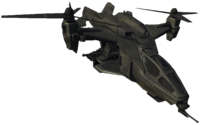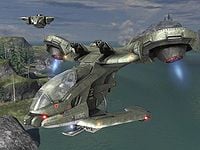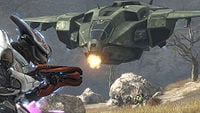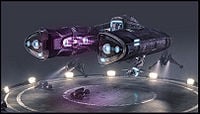VTOL: Difference between revisions
From Halopedia, the Halo wiki
(→UNSC: Added links and fixed typos.. I think) Tag: Mobile edit |
m (→List of appearances: Replacing link) |
||
| Line 94: | Line 94: | ||
*''[[Halo Legends]]'' | *''[[Halo Legends]]'' | ||
**''[[Prototype]]'' | **''[[Prototype]]'' | ||
**''[[The Package]]'' | **''[[The Package (animated short)|The Package]]'' | ||
**''[[Homecoming]]'' | **''[[Homecoming]]'' | ||
**''[[Origins]]'' | **''[[Origins]]'' | ||
Revision as of 13:02, June 19, 2020
| There is more information available on this subject at VTOL on the English Wikipedia. |
- "Radio for VTOL, heavy lift gear."
- — Sergeant Major Avery J. Johnson[1]
Vertical Take-off and Landing, abbreviated to VTOL, is a classification of aircraft meaning that take-off and landing, rather than needing a runway down which a craft travels to build up speed and lift, is conducted vertically by thrusters or propellers. The key advantage of VTOL capability is that it enables an aircraft to hover over an area, allowing for longer loiter time, and allow the craft to operate from a diverse array of airfields, using less space to get airborne. VTOL capability uses more fuel than Conventional-Takeoff-and-Landing (CTOL) capability, though.[2]
UNSC

For the most part, UNSC aircraft use jet thrusters mounted on pivots to provide vertical thrust. The dominant advantage of this is that it is capable of being used for conventional thrust as well, including horizontal and lateral thrust, by tilting the jet engines. Aircraft such as the D77-TC Pelican, the AC-220 Vulture gunship, and the AV-14 Hornet use this type of VTOL configuration. In addition the UH-144 Falcon, in service with the UNSC Army, is also a VTOL craft.
Another method is by using spinning propellers to provide lift, such as ducted fans or traditional helicopter rotors. Although not as lightweight or economic as jet thrusters, ducted fans provide a higher thrust-to-weight ratio, and can be more efficient, as well as having the advantage of producing less noise, always an advantage in a combat vehicle. Aircraft such as the AV-22 Sparrowhawk use ducted fans to generate lift, with a fan shrouded in each wing[3]. Although there appear to be no UNSC combat helicopters in service, dropships having supplanted these in their traditional role as air cavalry and gunship support, helicopters are still used by civilian operators.[4]
Covenant
Covenant craft use artificial gravity generators to provide lift. These craft are carried on a cushion of anti-gravity, produced by artificial gravity generators. The Type-25 Spirit and Type-52 Phantom dropships are VTOL-capable craft, with the former using an artificial gravity field produced between its two side booms, and the latter using a somewhat more logical layout of ventral hull-mounted generators.
VTOL aircraft
Gallery
A UNSC D77-TC Pelican, a VTOL dropship.



